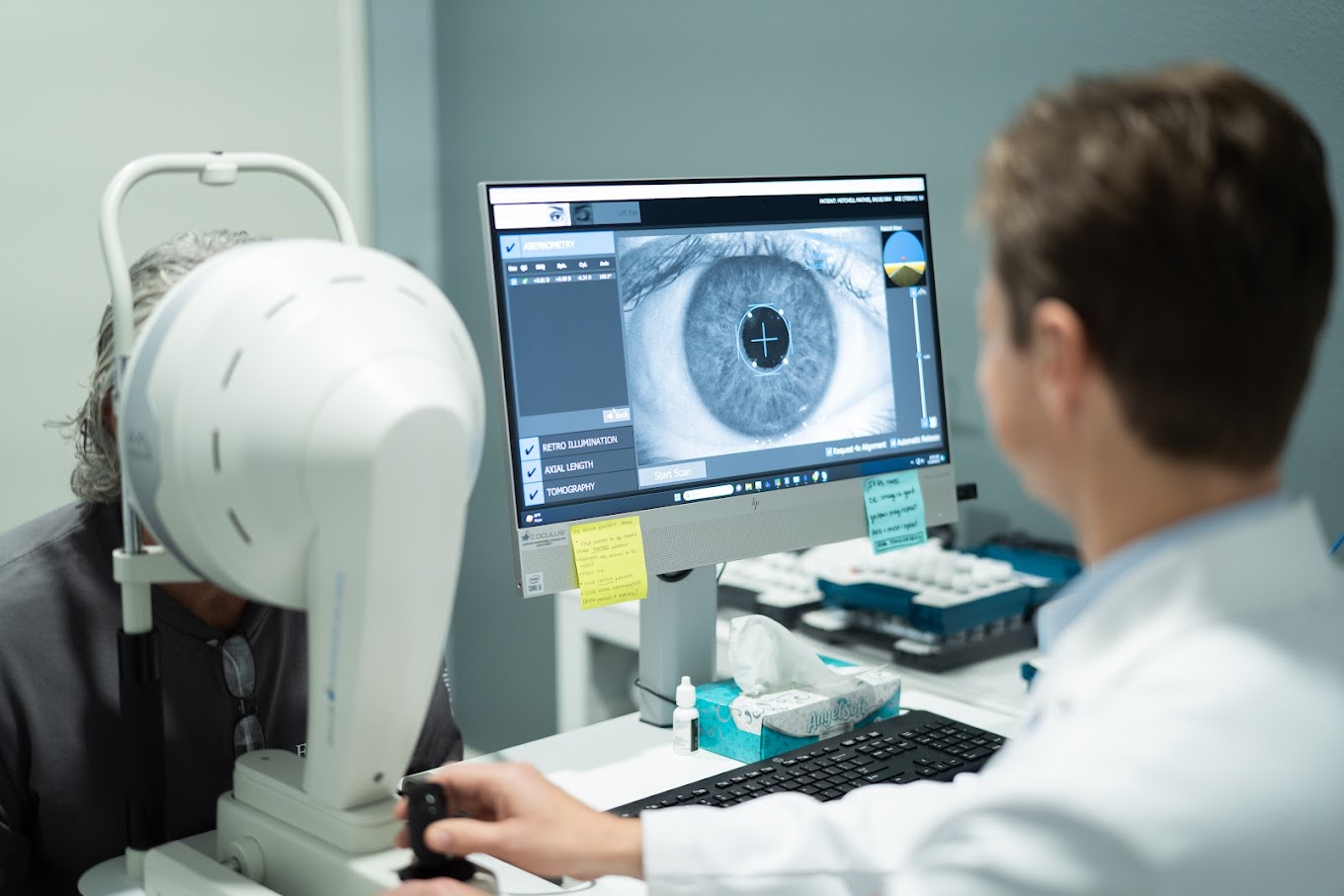
Understanding how air pollution impacts dry eye disease is vital for preserving your eye health. At Insight Vision Center Optometry, we know that experiencing symptoms like dryness, irritation, or visual fatigue can be frustrating. This page will help you understand the risks associated with environmental pollutants and why regular visits to our eye doctors can make a difference in your comfort and well-being.
Air Pollution and Dry Eye Disease: Exploring Their Relationship
Air pollution is widely recognized for its adverse effects on cardiovascular health, respiratory diseases, and even neurological disorders. In recent years, increasing attention has been paid to how polluted air may also affect the ocular surface. Dry eye disease (DED), a condition characterized by tear film instability, inflammation, and discomfort such as redness, grittiness, and visual fatigue, continues to rise in prevalence around the world. Although many risk factors—such as age, gender, and lifestyle habits—have been associated with DED, the potential influence of air pollutants remains an area of growing interest and concern.
Dry eye disease not only causes discomfort and visual impairment in millions of individuals but also imposes a significant socioeconomic burden due to reduced productivity and increased healthcare visits. While epidemiological research has traditionally focused on the cardiopulmonary effects of air pollution, the ocular surface, which is in continuous direct contact with the ambient environment, may be uniquely vulnerable to these pollutants. In this article, we summarize the current evidence linking air pollution to dry eye disease, highlight research findings from various regions—including the rapidly growing city of Urumqi in northwest China—and discuss potential mechanisms and mitigation strategies.
Numerous studies have indicated that pollutants such as particulate matter (PM), nitrogen dioxide (NO₂), sulfur dioxide (SO₂), carbon monoxide (CO), and even ozone (O₃) are implicated in various ocular conditions. Despite the protective barrier provided by the tear film, some pollutants can penetrate or disrupt the delicate balance of the ocular surface, leading to subclinical inflammation and tear film instability that may predispose individuals to DED.
Understanding Dry Eye Disease and Its Prevalence
Dry eye disease is defined as a multifactorial disorder of the ocular surface that arises from an imbalance in tear film homeostasis. Clinical manifestations include ocular discomfort, increased tear osmolarity, tear film instability, inflammation of the conjunctiva and cornea, and, over time, direct ocular surface damage. The condition is especially prevalent among postmenopausal women, and studies have noted that in North America, nearly 7.8% of women and 4.7% of men over the age of 50 suffer from severe symptoms.
In Asia, and more specifically in China, the prevalence of DED has been reported to range between 17% and 21% in the general population, with outpatient clinics reporting figures as high as 61.57%. Recent national surveys have highlighted regional differences within China, with higher prevalence reported in the western and northern regions compared with the southeastern areas. These regional variations underscore the importance of environmental and climatic factors, including ambient air quality.
Aside from demographic factors such as age and gender, lifestyle elements like chronic sleep deficiency, prolonged use of digital screens, and even smoking have been implicated in exacerbating dry eye symptoms. However, relatively fewer studies have focused on the role of environmental pollutants. The ocular surface’s direct exposure to ambient air and its inherent vulnerability render it an important, yet often overlooked, target for studying pollution-related health effects.

How Air Pollution Affects the Ocular Surface
The ocular surface is composed primarily of the corneal and conjunctival epithelia, which are protected by a thin, multi-layered tear film. This film functions to lubricate the eye, remove debris, and serve as a barrier against pathogens and environmental irritants. However, in polluted environments, particulate matter and reactive gaseous compounds can disrupt this delicate balance.
The following mechanisms have been proposed to explain how air pollution may lead to dry eye disease:

Evidence from Epidemiological Studies
Epidemiological studies have investigated the association between air pollution and dry eye disease by analyzing outpatient visits, self-reported symptoms, and clinical signs. Time-series analyses conducted in various regions—including eastern cities in China, Taiwan, and South Korea—have generally found a positive correlation between increased levels of pollutants and the incidence of dry eye disease outpatient visits.
In one study conducted in Urumqi, the capital of Xinjiang in northwest China, researchers aimed to investigate the relationship between six major air pollutants and dry eye disease outpatient visits. Urumqi, known for its harsh climatic conditions—characterized by large temperature variations, dryness, and frequent sand-dust storms—is an ideal location to study air pollution effects on ocular health. Despite its rapid economic growth and increased vehicular emissions, few studies had examined the direct impact of local air pollution on eye health in this region.
Using a retrospective time-series design with a large sample of outpatient data collected between 2013 and 2020, researchers analyzed various pollutants, including particulate matter (PM₂.₅ and PM₁₀), NO₂, SO₂, CO, and ozone. They applied statistical models that adjusted for confounding variables such as meteorological factors (temperature, humidity, wind speed) and even considered lag effects—investigating how exposure on a given day might influence DED visits several days later. Evidence from these models suggested that short-term exposure to key pollutants, particularly PM₂.₅, NO₂, and SO₂, was significantly associated with an increased risk of dry eye disease outpatient visits.
Similar findings have emerged from other regions. For instance, in urban centers of South Korea and eastern China, higher concentrations of traffic-related pollutants have been linked with both increased symptoms and more frequent hospital visits for DED. In addition, several studies have noted that these effects may be more pronounced in certain subgroups—for example, younger patients or women may be more sensitive to specific pollutants.

Lagged Effects and Exposure Duration
One unique methodological approach in environmental epidemiology is the use of distributed lag non-linear models (DLNM). These models help researchers understand not only the immediate effects of air pollution exposure on health outcomes but also delayed or cumulative effects over several days. In the context of dry eye disease, DLNM-based studies have shown that the adverse impact of pollutants such as PM₂.₅, NO₂, and SO₂ may not be confined to the same day as the exposure.
For example, a study in Guangzhou, a major megacity in southern China, found that each 10 μg/m³ increase in PM₂.₅ was associated with a significant rise in the number of DED outpatient visits. The highest relative risks were often observed at lag 0 (the same day), but cumulative lag effects (spanning up to 13 days) suggested that prolonged or repeated exposures further increase the risk.
The concept of lagged effects is important because it reinforces that the impact of air pollutants on the ocular surface may accumulate over several days of exposure. This understanding is vital for public health planning as it suggests that even transient spikes in air pollution can translate into sustained increases in DED symptoms and related healthcare utilization.
Regional and Demographic Variations
Air quality and climatic conditions vary greatly from region to region, which in turn influences the prevalence and severity of dry eye symptoms. In Urumqi, the extremely dry and dusty conditions, coupled with high emissions from road transport and industrial sources, create an environment in which the ocular surface is particularly at risk. In contrast, other cities with higher humidity may have a different risk profile.
Additionally, demographic factors play a role. Multiple studies have demonstrated that dry eye disease is more common among women than men, possibly due to hormonal influences on tear film composition and meibomian gland function. In some analyses, however, men have shown a stronger association between pollutant exposure and severe dry eye symptoms—potentially explained by differences in time spent outdoors or occupational exposures.
Age is another important modifier. While DED is generally more prevalent among older adults, some studies have indicated that younger individuals may be more susceptible to the acute effects of air pollutants—perhaps because of higher outdoor activity levels or greater use of digital screens, which can further strain the ocular surface.

Potential Mitigation Strategies
Given the growing evidence linking air pollution with dry eye disease, both individual and public health interventions are needed to mitigate these adverse effects. Some potential strategies for reducing ocular exposure to harmful pollutants include:

The Highest Rated Advanced Eye Care Center In Orange County

What Our Patients are Saying
“I love this office! The staff is so friendly, helpful, and welcoming. Dr. Lam has helped with my dry eye symptoms and myopia and takes the time to explain things thoroughly. I never feel like she is rushing me out of the office to see the next patient. She is extremely knowledgeable and I feel very well cared for. I highly recommend this office!”
⭐⭐⭐⭐⭐
Elaine N.
“More recently I had an issue with super dry eyes and they provided me multiple solutions and care instructions to heal them quickly. What I like is that it’s not all about just solving the issue, they taught me about long term care and what to change to ensure my eyes get the hydration they need.”
⭐⭐⭐⭐⭐
Maria M.
The Research
- Liang et al. (2023) – Dry Eye in Urumqi, China
Liang, K., Gui, S.-Y., Qiao, J.-C., Wang, X.-C., Yang, F., Tao, F.-B., Yi, X.-L., & Jiang, Z.-X. (2023). Association between air pollution exposure and daily outpatient visits for dry eye disease: A time-series study in Urumqi, China. Atmosphere, 14(1), 90. https://doi.org/10.3390/atmos14010090 - Mandell et al. (2020) – Impact of Air Pollution on Dry Eye
Mandell, J. T., Idarraga, M., Kumar, N., Galor, A., et al. (2020). Impact of air pollution and weather on dry eye. Journal of Clinical Medicine, 9(11), 3740. https://doi.org/10.3390/jcm9053740 - Chua et al. (2023) – Air Pollution and Chronic Eye Disease (Scoping Review)
Millen, A. E., Dighe, S., Kordas, K., Aminigo, B. Z., Zafron, M. L., & Mu, L. (2023). Air Pollution and Chronic Eye Disease in Adults: A Scoping Review. Ophthalmic Epidemiology, 31(1), 1–10. https://doi.org/10.1080/09286586.2023.2183513 - Association between Traffic-Related Air Pollution and Dry Eye in South China
Cao, F., Chen, Y., Gui, YC. et al. Association between traffic-related air pollution and risk of outpatient visits for dry eye disease in a megacity along the subtropical coast in South China. BMC Public Health 25, 151 (2025). https://doi.org/10.1186/s12889-025-21319-0 - JAMA Ophthalmology Article on Dry Eye Disease Huang A, Janecki J, Galor A, et al. Association of the Indoor Environment With Dry Eye Metrics. JAMA Ophthalmol. 2020;138(8):867–874. doi:10.1001/jamaophthalmol.2020.2237 https://jamanetwork.com/journals/jamaophthalmology/fullarticle/2767886

Protect Your Eyes from Air Pollution
Dry eye disease isn’t just about occasional discomfort—it can genuinely affect your daily life, making simple tasks like reading, driving, or using a smartphone feel exhausting. We’ve seen firsthand how air pollution, often overlooked, is quietly becoming a major player in eye health. Pollutants like particulate matter and gases such as nitrogen dioxide can subtly damage your eyes over time, creating inflammation and irritation that traditional treatments may not fully address.
Think of your eyes like the windshield of your car—always exposed, constantly protecting you, but also vulnerable to dirt and grime. Regular visits to your eye doctor aren’t just about vision tests or new glasses. They’re your best line of defense against these invisible threats, helping you maintain healthy tears, stable vision, and comfort, even in challenging environments.
So, if you’ve noticed dryness, redness, or that gritty feeling in your eyes—don’t ignore it. It’s your body’s way of saying, “Hey, something’s up.” Schedule a visit with our eye care team. We’ll help you understand what’s happening with your eyes, provide personalized treatments, and guide you on practical ways to protect your vision. Let’s keep your eyes healthy, together.

Why choose Insight Vision Center Optometry in Costa Mesa, CA, for Dry Eye Treatment?
Insight Vision Center Optometry is a premier advanced eye care clinic in Orange County, known for its advanced solutions for treating dry eye and ocular surface diseases. With over 600 positive patient reviews and a 4.9-star rating on Google and Yelp, our highly trained eye doctors utilize state-of-the-art IPL and other technologies to deliver safe and effective treatments.
If you’re interested in exploring Dry Eye Treatment, contact Insight Vision Center Optometry in Costa Mesa, CA
Call us at (714) 942-1361 to book your appointment, or schedule online.





